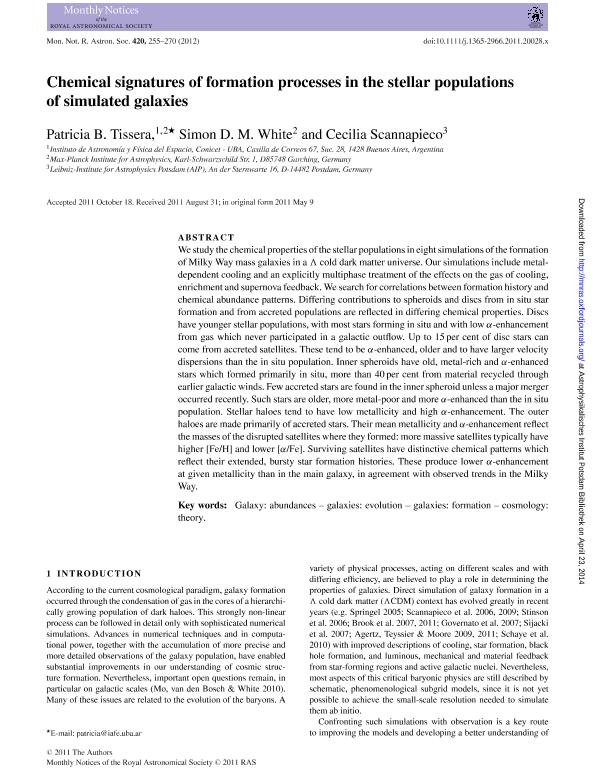Mostrar el registro sencillo del ítem
dc.contributor.author
Tissera, Patricia Beatriz

dc.contributor.author
White, Simon D. M.
dc.contributor.author
Scannapieco, Cecilia

dc.date.available
2017-06-22T17:48:22Z
dc.date.issued
2012-02
dc.identifier.citation
Tissera, Patricia Beatriz; White, Simon D. M.; Scannapieco, Cecilia; Chemical signatures of formation processes in the stellar populations of simulated galaxies; Oxford University Press; Monthly Notices Of The Royal Astronomical Society; 420; 1; 2-2012; 255-270
dc.identifier.issn
0035-8711
dc.identifier.uri
http://hdl.handle.net/11336/18655
dc.description.abstract
We study the chemical properties of the stellar populations in eight simulations of the formation of Milky Way mass galaxies in a cold dark matter universe. Our simulations include metaldependent cooling and an explicitly multiphase treatment of the effects on the gas of cooling, enrichment and supernova feedback. We search for correlations between formation history and chemical abundance patterns. Differing contributions to spheroids and discs from in situ star formation and from accreted populations are reflected in differing chemical properties. Discs
have younger stellar populations, with most stars forming in situ and with low α-enhancement from gas which never participated in a galactic outflow. Up to 15 per cent of disc stars can come from accreted satellites. These tend to be α-enhanced, older and to have larger velocity dispersions than the in situ population. Inner spheroids have old, metal-rich and α-enhanced stars which formed primarily in situ, more than 40 per cent from material recycled through earlier galactic winds. Few accreted stars are found in the inner spheroid unless a major merger occurred recently. Such stars are older, more metal-poor and more α-enhanced than the in situ population. Stellar haloes tend to have low metallicity and high α-enhancement. The outer haloes are made primarily of accreted stars. Their mean metallicity and α-enhancement reflect the masses of the disrupted satellites where they formed: more massive satellites typically have higher [Fe/H] and lower [α/Fe]. Surviving satellites have distinctive chemical patterns which reflect their extended, bursty star formation histories. These produce lower α-enhancement at given metallicity than in the main galaxy, in agreement with observed trends in the Milky Way.
dc.format
application/pdf
dc.language.iso
eng
dc.publisher
Oxford University Press

dc.rights
info:eu-repo/semantics/openAccess
dc.rights.uri
https://creativecommons.org/licenses/by-nc-sa/2.5/ar/
dc.subject
Galaxies:Abundances
dc.subject
Galaxies:Evolution
dc.subject
Galaxies:Formation
dc.subject
Cosmology:Theory
dc.subject.classification
Astronomía

dc.subject.classification
Ciencias Físicas

dc.subject.classification
CIENCIAS NATURALES Y EXACTAS

dc.title
Chemical signatures of formation processes in the stellar populations of simulated galaxies
dc.type
info:eu-repo/semantics/article
dc.type
info:ar-repo/semantics/artículo
dc.type
info:eu-repo/semantics/publishedVersion
dc.date.updated
2017-06-21T18:56:18Z
dc.journal.volume
420
dc.journal.number
1
dc.journal.pagination
255-270
dc.journal.pais
Reino Unido

dc.journal.ciudad
Oxford
dc.description.fil
Fil: Tissera, Patricia Beatriz. Consejo Nacional de Investigaciónes Científicas y Técnicas. Oficina de Coordinación Administrativa Ciudad Universitaria. Instituto de Astronomía y Física del Espacio. - Universidad de Buenos Aires. Facultad de Ciencias Exactas y Naturales. Instituto de Astronomía y Física del Espacio; Argentina
dc.description.fil
Fil: White, Simon D. M.. Gobierno de la Republica Federal de Alemania. Max Planck Institut Fur Astrophysik; Alemania
dc.description.fil
Fil: Scannapieco, Cecilia. Consejo Nacional de Investigaciónes Científicas y Técnicas. Oficina de Coordinación Administrativa Ciudad Universitaria. Instituto de Astronomía y Física del Espacio. - Universidad de Buenos Aires. Facultad de Ciencias Exactas y Naturales. Instituto de Astronomía y Física del Espacio; Argentina. Leibniz-Institute for Astrophysics Potsdam; Alemania
dc.journal.title
Monthly Notices Of The Royal Astronomical Society

dc.relation.alternativeid
info:eu-repo/semantics/altIdentifier/ark/https://academic.oup.com/mnras/article-lookup/doi/10.1111/j.1365-2966.2011.20028.x
dc.relation.alternativeid
info:eu-repo/semantics/altIdentifier/doi/http://dx.doi.org/10.1111/j.1365-2966.2011.20028.x
dc.relation.alternativeid
info:eu-repo/semantics/altIdentifier/url/https://arxiv.org/abs/1110.5864
Archivos asociados
